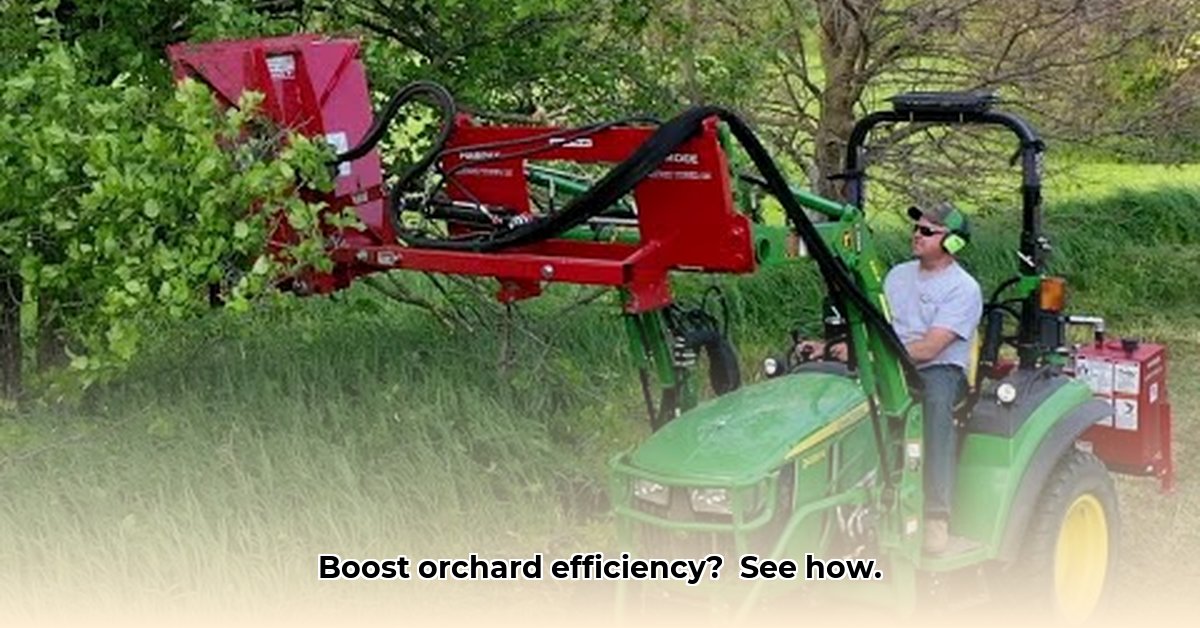
Keeping your orchard healthy and productive requires efficient pruning, and the right tools are key. With rising steel prices and a growing focus on sustainable practices, selecting the optimal equipment is crucial. This article compares two popular tractor limb cutters—the Quadsaw LRS 1602 and the Limb Beaver—to help you make an informed decision. We'll analyze their features, pros, cons, efficiency, sustainability, and long-term implications to guide you toward the best choice for your farm. For more information on tractor attachments, check out this helpful resource: tractor parts.
Quadsaw LRS 1602: Versatile Performance
The Quadsaw LRS 1602 stands out for its versatility, compatible with various vehicles beyond tractors. This flexibility offers significant advantages for farmers with diverse equipment needs. Its efficient power transfer minimizes energy waste, leading to lower fuel costs. The blades produce clean, smooth cuts, promoting faster tree healing and overall orchard health. With proper maintenance, blade life extends up to 200 hours with regular sharpening, potentially even longer with optimal care. Isn't maximizing your equipment's lifespan a key factor in reducing long-term costs?
Pros:
- Versatile mounting options for increased flexibility.
- Energy-efficient design reduces fuel consumption.
- Precise cuts promote faster tree healing and growth.
- Durable blades provide extended operational life.
Cons:
- Higher initial investment compared to some alternatives. Specific pricing depends on the vendor and current market conditions.
- Requires periodic blade sharpening, adding to ongoing maintenance expenses.
- Unexpected repairs, though infrequent with proper maintenance, represent a potential cost.
Limb Beaver: Speed and Power for Large Orchards
The Limb Beaver prioritizes speed and power, making it ideal for large-scale pruning operations. Its design for tractors or skid steers ensures robust performance in demanding conditions. The high RPM and multiple teeth are engineered for rapid clearing, significantly increasing efficiency for larger orchards. However, precise lifespan data for the cutting teeth is currently unavailable, which is an important factor to consider. Maintaining the Limb Beaver requires a case drain line, adding a degree of complexity to regular servicing. Like the Quadsaw, the rising cost of steel impacts its overall cost-effectiveness. Does the increase in speed justify the potential increase in maintenance complexity?
Pros:
- High cutting speed ideal for large-scale pruning.
- Robust teeth designed to withstand heavy-duty use.
- Specifically designed for tractor or skid steer compatibility.
Cons:
- Imprecise knowledge of cutting teeth lifespan necessitates cautious monitoring.
- Requires a case drain line for maintenance, increasing servicing complexity.
- Cost varies greatly depending on supplier and market conditions; obtaining precise pricing is challenging.
Comparative Analysis: Choosing the Right Tool for Your Farm
Selecting between the Quadsaw LRS 1602 and the Limb Beaver depends on your specific needs and budget. The Quadsaw's versatility might justify its higher initial investment for farmers needing flexible equipment deployment. However, if prioritizing speed and power for large-scale clearing is paramount, the Limb Beaver's efficiency might outweigh its potential maintenance complexities.
| Feature | Quadsaw LRS 1602 | Limb Beaver |
|---|---|---|
| Mounting Options | Versatile (Tractors & more) | Tractors/Skid Steers |
| Cutting Speed | Moderate | High |
| Blade/Tooth Life | Up to 200 hours (with sharpening) | Variable; further data needed |
| Maintenance | Regular sharpening | Case drain line required; potentially more involved |
| Cost | Varies; contact supplier for pricing | Varies; contact supplier for pricing |
| Sustainability | Requires further research | Requires further research |
Sustainability Considerations: Environmental Impact
Both limb cutters utilize steel, a key factor in evaluating their environmental impact given rising steel prices and increasing sustainability concerns. Comprehensive data on the total environmental impact—including manufacturing emissions and component recyclability—is currently lacking. This highlights the need for further research to fully assess the long-term ecological implications of each option. What does a sustainable future for orchard management look like?
Long-Term Implications & Recommendations
Navigating the choice between these limb cutters requires careful consideration of several key factors: budget, maintenance capabilities, orchard size, and long-term sustainability goals. For smaller operations, leasing might be a more financially viable option than outright purchase. Prioritizing quality and durability in your selection minimizes the need for frequent replacements and reduces long-term costs. Staying updated on emerging technologies and more sustainable material choices will allow you to make even better informed decisions in the future.
Actionable Steps for Orchard Owners:
- Assess your budget and maintenance capacity. Leasing might be a better option than a large capital expenditure.
- Consider used or smaller models if budgetary constraints are significant.
- Invest in high-quality equipment for long-term reliability.
- Stay informed about emerging technologies and materials in agricultural machinery.
- Develop a preventative maintenance plan to extend the life of your equipment and reduce unexpected costs.
Conclusion: A Sustainable Future for Orchard Management
The agricultural landscape is constantly evolving. Manufacturers continuously innovate in material science and sustainable design. Making the optimal choice for your limb cutter requires a thorough evaluation of your unique needs, budget, and future goals. Remembering the importance of sustainable practices is crucial for maintaining both profitability and environmental stewardship; a sustainable approach benefits both the orchard and the planet.